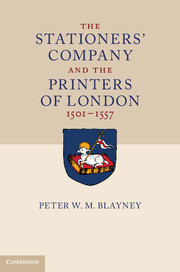Book contents
- Frontmatter
- Dedication
- Contents
- List of illustrations
- Preface
- Acknowledgements
- Permissions
- Conventions
- List of abbreviations
- 1 1357–1500
- 2 1501–1509
- 3 1510–1520
- 4 1521–1528
- 5 1529–1534
- 6 1535–1541
- 7 1535–1541
- 8 1542–1546
- Endnotes to Volume I
- 9 1547–1553
- 10 1553–1557
- 11 1554–1557
- 12 1501–1557
- APPENDIXES
- Bibliography
- Index of STC numbers
- General index
12 - 1501–1557
Conclusion
Published online by Cambridge University Press: 05 November 2014
- Frontmatter
- Dedication
- Contents
- List of illustrations
- Preface
- Acknowledgements
- Permissions
- Conventions
- List of abbreviations
- 1 1357–1500
- 2 1501–1509
- 3 1510–1520
- 4 1521–1528
- 5 1529–1534
- 6 1535–1541
- 7 1535–1541
- 8 1542–1546
- Endnotes to Volume I
- 9 1547–1553
- 10 1553–1557
- 11 1554–1557
- 12 1501–1557
- APPENDIXES
- Bibliography
- Index of STC numbers
- General index
Summary
In 1741 the anonymous compiler of The Charter and Grants of the Company of Stationers first made the Company's charter available to the public in both Latin and English. Unfortunately he misinterpreted the date of ‘the 4th Day of May…In the Third and Fourth of PHILIP and MARY’ as meaning 1556 instead of 1557: an error repeated by every subsequent commentator from Ames in 1749 to Arber in the 1870s, and therefore still catching unwary amateurs today. The first book-trade historian to mention and quote the document was Ames, who was aware that there had been stationers, textwriters, paternoster makers and the like in England long before Caxton.
They were of great antiquity, even before the art of Printing was invented; yet hitherto I have not been able to find their priviledge, or charter, though several of the old printers are said to be of the stationer's company, nor had [they] any authority granted them with relation to printed books as a company, till the…charter was made in 1556.
Aside from the date he was right about three key points: that the Company was older than printing, that at least some printers belonged to it before Mary's reign, but that the charter was the first official document that gave the Stationers ‘any authority…with relation to printed books as a company’.
- Type
- Chapter
- Information
- The Stationers' Company and the Printers of London, 1501–1557 , pp. 927 - 935Publisher: Cambridge University PressPrint publication year: 2013



